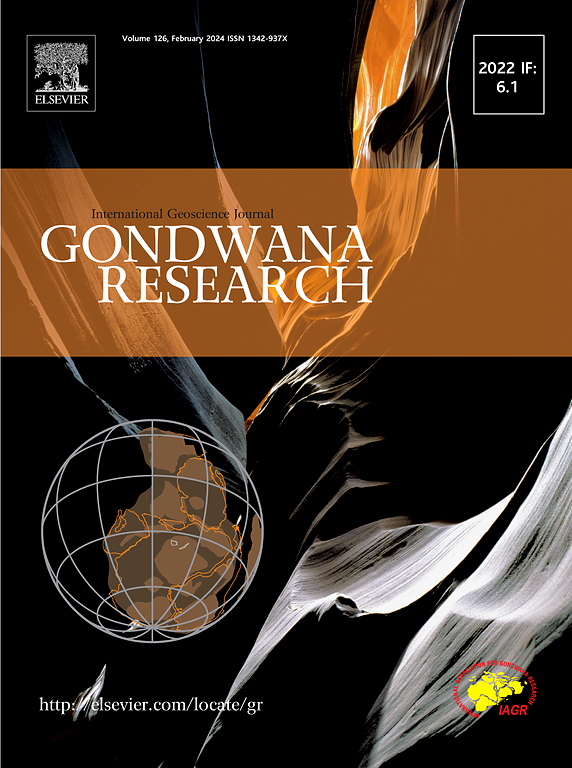背斜构造圈闭地下储气库抬升沉降影响区域的确定——来自InSAR互相关的启示
IF 7.2
1区 地球科学
Q1 GEOSCIENCES, MULTIDISCIPLINARY
引用次数: 0
摘要
本文研究了意大利Po平原盆地3个UGS气田的地下储气库(UGS)作业与地面变形之间的关系。对2015年至2021年的Sentinel-1 InSAR数据进行了分析,以量化与循环注入和提取天然气相关的季节性隆起和沉降模式。该方法使用交叉相关参数R和K来评估UGS活动与垂直位移季节性振幅之间的相关性,该参数测量垂直位移时间序列与天然气体积波动之间的形状(R)和规模(K)相似性。结果表明,随着UGS注入/回采计划实施至2021年,季节性驱替峰值出现在气田边界内,并向外减弱。沿着背斜圈闭的主轴,ugs相关的垂直位移在到达场边界之前停止,而横向上,它们延伸到大约0.5 km以外。使用季节振幅、R和K值的频率分布来定义R和K的阈值,从而能够定量识别UGS的有效影响区域,而GNSS数据提供了额外的约束条件。研究结果强调了构造圈闭几何形状和边界断裂对地表沉降和隆升模式的影响。这些发现强调了先进的监测技术和对地下地质的全面了解对于有效管理UGS作业的必要性。随着全球储气需求的增加,将地质力学建模与地面变形监测相结合将加强风险评估,确保操作安全,并优化储气策略。提出的方法为监测诱发的地面变形提供了有价值的见解,为可持续和有效的UGS管理提供了框架。本文章由计算机程序翻译,如有差异,请以英文原文为准。

Defining the influence area of uplift and subsidence from underground gas storage in anticline structural traps: Insights from InSAR cross-correlation
We investigate the relationship between Underground Gas Storage (UGS) operations and ground deformation of three UGS fields in the Po Plain basin, Italy, hosted in Pliocene clastic deposits within anticline structural traps. Sentinel-1 InSAR data from 2015 to 2021 were analyzed to quantify seasonal uplift and subsidence patterns associated with the cyclic injection and withdrawal of gas. The methodology evaluates correlations between UGS activity and the seasonal amplitude of vertical displacement using cross-correlation parameters R and K, which measure the shape (R) and scale (K) similarity between vertical displacement time series and gas volume fluctuations. Results show that, with the UGS injection/withdrawal plan implemented until 2021, seasonal displacement peaks occur within gas field boundaries and diminish outward. Along the major axis of the anticline traps, UGS-related vertical displacements cease before reaching the field boundary, while transversally, they extend up to approximately 0.5 km beyond. Frequency distributions of seasonal amplitude, R and K values were used to define threshold values for R and K, enabling a quantitative identification of the effective UGS influence area, with GNSS data providing additional constraints. Our findings highlight the influence of structural trap geometry and bounding faults in shaping surface subsidence and uplift patterns. These findings underscore the need for advanced monitoring technologies and a comprehensive understanding of subsurface geology to an effective management of UGS operations. As global demand for gas storage increases, integrating geomechanical modeling with ground deformation monitoring will enhance risk assessment, ensure operational safety, and optimize gas storage strategies. The proposed methodology provides valuable insights for monitoring induced ground deformation, offering a framework for sustainable and effective UGS management.
求助全文
通过发布文献求助,成功后即可免费获取论文全文。
去求助
来源期刊

Gondwana Research
地学-地球科学综合
CiteScore
12.90
自引率
6.60%
发文量
298
审稿时长
65 days
期刊介绍:
Gondwana Research (GR) is an International Journal aimed to promote high quality research publications on all topics related to solid Earth, particularly with reference to the origin and evolution of continents, continental assemblies and their resources. GR is an "all earth science" journal with no restrictions on geological time, terrane or theme and covers a wide spectrum of topics in geosciences such as geology, geomorphology, palaeontology, structure, petrology, geochemistry, stable isotopes, geochronology, economic geology, exploration geology, engineering geology, geophysics, and environmental geology among other themes, and provides an appropriate forum to integrate studies from different disciplines and different terrains. In addition to regular articles and thematic issues, the journal invites high profile state-of-the-art reviews on thrust area topics for its column, ''GR FOCUS''. Focus articles include short biographies and photographs of the authors. Short articles (within ten printed pages) for rapid publication reporting important discoveries or innovative models of global interest will be considered under the category ''GR LETTERS''.
 求助内容:
求助内容: 应助结果提醒方式:
应助结果提醒方式:


